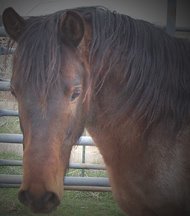
Antacids
Antacids reduce the pain that occurs when stomach acid irritates nerves in the stomach lining by “buffering,” or raising the pH of the stomach environment to reduce its acidity. Most antacids employ calcium carbonate, magnesium hydroxide, or aluminum hydroxide as their active ingredients.
Although antacids do effectively reduce stomach acidity, their effect appears to be very short term (an hour or less) unless the dosage is higher than 240 milliliters, or approximately 8 ounces. The standard, recommended dose of equine antacids is 1-2 ounces.
Antacids are most effective when administered frequently (at least 4 times daily) and immediately preceding exercise. Their true benefit may be in relieving ulcer pain long enough to allow a horse to eat in comfort. The natural reduction in stomach acidity as a result of forage consumption then promotes additional eating, beginning an upward spiral.
Unfortunately, long term antacid use is not without risk. Many antacid supplements include magnesium, which retards calcium absorption. Because calcium deficiency can cause bone and muscle weakness and even aberrations in heart rhythm, this possibility bears particular consideration for equine athletes. Additionally, antacids may reduce the effectiveness of other oral medications by interfering with absorption; they may also affect normal urinary excretion of certain drugs.
Below are notes on several of the most common equine antacids:
U-Guard – Available in powder or pellet form. Mixed anecdotal reviews on effectiveness and palatability. Approximate cost: $15/month for powder or $30/month for pellets.
NeighLox – Available in pellet form. Mixed anecdotal reviews on effectiveness and palatability. Approximate cost: $95/month.
Pro CMC – Available in liquid form. Limited but positive anecdotal reviews on effectiveness when administered by oral syringe before exercise. Approximate cost: $30/month.
Digestive Aids
“Digestive aids” is a catch-all term for products reputed to improve general intestinal health. Some of these products claim to reduce ulcer symptoms or prevent ulcers; others are not labeled as ulcer supplements but boast anecdotal support for their positive impact on EGUS.
Probiotics – Probiotics are live microbes that exist naturally in the digestive tract. As beneficial bacteria, they are thought to promote health by suppressing the growth of unfriendly bacteria, improving the immune function, and enhancing the protective barrier of the digestive tract. Daily stressors, particularly in an emotional or hardworking horse, can upset the natural, bacterial balance of the gut. Probiotic supplementation attempts to stabilize friendly microbe populations through frequent ingestion of live or freeze-dried organisms. Clinical proof of the effectiveness of probiotic supplementation in soothing equine gastric ulcers is limited, though anecdotal evidence abounds.
L-Glutamine – L-Glutamine is an amino acid, one of the building blocks from which proteins are constructed, and among its primary functions is the nourishment of cells in the protective lining of the digestive tract. Although L-Glutamine is generally considered non-essential, that is, a normal body produces it in sufficient quantity, evidence suggests that an equine under stress (including travel, illness, athletic conditioning, disrupted social environment, etc.) may require dietary supplementation.
Digestive Conditioners – A variety of products market themselves as digestive conditioners. Most of these products combine fiber, probiotics, and amino acids in an effort to improve overall digestive health, including, in some cases, the easing or prevention of EGUS. Other ingredients may include polar lipids (fats that protect intestinal lining), threonine (an essential amino acid necessary for the production of protective mucus), and various immune system stimulants.
Below are notes on two of the most common equine digestive aids:
G.U.T –Ulcer supplement containing L-Glutamine, probiotics, and more. Available in powder and paste form. Mostly positive anecdotal reviews on effectiveness and palatability. Approximate cost: $20/month.
Succeed – Digestive conditioner containing L-Glutamine, probiotics, soluble fiber, and more. Advertised as all natural. Available in granular and paste form. Mostly positive anecdotal reviews on effectiveness; mixed anecdotal reviews on palatability. Approximate cost: $100/month.
Natural Alternatives
Gastric ulcers are nothing new, and many natural substances have been used for centuries to soothe and protect ulcerated stomach lining. Research on the effectiveness of these substances is limited, just as with antacids and digestive conditioners, but a great many individuals swear by them.
Below are notes on some of the most common natural ulcer supplements:
Seabuckthorn berries – Reportedly provides benefits including improved mental focus, enhanced digestive health, and bolstered immune system. The equine product Seabuck Complete is available in liquid form. Approximate cost: $80/month.
Papaya juice – Reportedly increases production of protective mucous in the gut, resulting in improved appetite and reduction of ulcer pain, diarrhea, and cribbing behavior. The equine product Stomach Soother is available in liquid form. Approximate cost $50/month.
Slippery elm bark, aloe, MSM, okra, and chamomile, previously discussed in this post, may also be used as natural ulcer supplements.
The Conclusion
There is no simple answer to the question of which ulcer supplement will work for any given horse. Research on the subject is limited and inconclusive, and results are so highly individualized that your only recourse is likely to be trial and error. I recommend testing one supplement at a time and taking careful notes on your horse’s attitude, appetite, and behavior as you determine the most appropriate regime for his well-being.
______________________________________________
Related Posts
Strategies for Prevention of Equine Gastric Ulcer Syndrome
Pharmaceutical and Alternative Treatment Options for EGUS
EGUS, Endurance, and the AERC
A Fair Question: Equine Athletes, Equine Ulcers
Bringing it Home: EGUS Prevention at In the Night Farm
Sheer Brilliance: Aloe and MSM as Alternative Therapy for EGUS
Q & A: Aloe and MSM as Alternative Therapy for EGUS
The Good Bad News: Gastric Ulcers in Equines ______________________________________________
Want to read more posts like this one? We deliver!
Subscribe to The Barb Wire









No comments:
Post a Comment